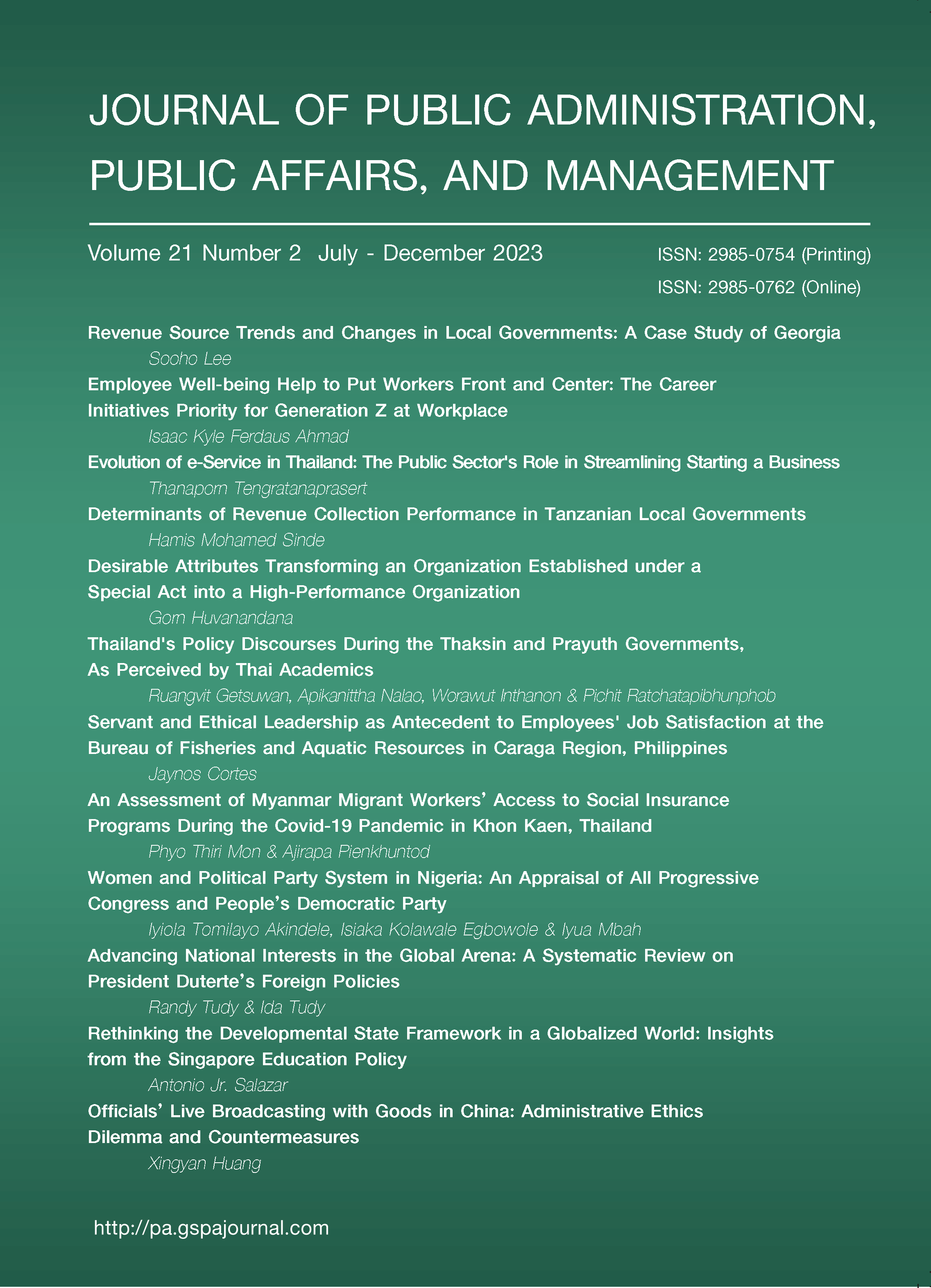Revenue Source Trends and Changes in Local Governments: A Case Study of Georgia
Keywords:
Local revenue sources, revenue diversification, special purpose local option sales tax, user feesAbstract
Financial stability poses a considerable challenge for many local governments, particularly during periods of resource unpredictability. While diversifying revenue sources is frequently touted as a remedy for fluctuating revenue streams, limited research has delved into the specific new revenue modalities adopted by local governments and how these have transformed their overall revenue structure. This research evaluates revenue diversification trends by analyzing revenue data spanning 1985 to 2015 from 121 of Georgia's largest cities. Findings indicate that special purpose option sales taxes emerged as a significant addition over the three decades. Concurrently, a growing number of local governments have embraced sources like hotel/motel taxes, business licenses, alcohol licenses, and parking fees. Notably, in a majority of the cities studied, revenues from enterprise funds surpassed those from general funds. The study concludes by drawing financial management implications from the observed trends.
References
ACCG. (2016). Special Purpose Local Option Sales Tax: A Guide for County Officials. 6th ed. Retrieved from https://www.accg.org/library/legal/SPLOST%202016.pdf.
Arapis, T. (2013). Enterprise fund transfers and their impact on governmental spending and
revenue patterns of Georgia municipalities. Journal of Public Budgeting, Accounting & Financial Management, 25(3), 446-473. doi:10.1108/JPBAFM-25-03-2013-B004
Bartle, J. R., Kriz, K. A., & Morozov, B. (2011). Local government revenue structure: Trends and challenges. Journal of Public Budgeting, Accounting & Financial Management, 23(2), 268-287. doi: 10.1108/JPBAFM-23-02-2011-B005
Berry, F. S., & Berry, W. D. (1994). The politics of tax increases in the States. American Journal of Political Science, 38(3), 855-859. doi:10.2307/2111610
Bland, R. L. (2013). A Budgeting Guide for Local Government. 3rd ed. New Jersey: ICMA Press.
Carroll, D. A. (2009). Diversifying municipal government revenue structures: Fiscal illusion or instability? Public Budgeting & Finance, 29(1), 27-48. doi:10.1111/j.1540-5850.2009.00922
City of Atlanta. (1996). 1997 Budget. Retrieved from https://www.atlantaga.gov/home/showdocument?id=17079.
Collins, S., Hanlon, B., & Scholz, E. (2009). Faltering economy: Time to thoughtfully challenge the status quo. Public Management, 2009, 6-9.
Cromwell, E., & Ihlanfeldt, K. (2015). Local government responses to exogenous shocks in revenue sources: Evidence from Florida. National Tax Journal, 68(2), 339-376. doi:10.17310/ntj.2015.2.05
Gentry, W. M., & Ladd, H. F. (1994). State tax structure and multiple policy objectives. National Tax Journal, 47(4), 747-772. doi.org/10.1086/NTJ41789106
Georgia Department of Community Affairs. (2017a). 2016 Georgia Local Government Finance Highlights. Retrieved from https://www.gacities.com/GeorgiaCitiesSite/media/PDF/DCA-2016-GLGF-HighlightsReport.pdf.
Georgia Department of Community Affairs. (2017b). 2017 Government Management Indicators Survey. Retrieved from https://www.dca.ga.gov/sites/default/files/2017citycatalogfinal.pdf.
Georgia Department of Revenue. (2023). Georgia Sales and Use Tax Rate Chart. Retrieved from https://dor.georgia.gov/sales-tax-rates-general.
Georgia Municipal Association (GMA). (2018). Municipal Revenues. Retrieved from https://www.gacities.com/Resources/GMA-Handbooks-Publications/Handbook-for-Georgia-.
International City/County Management Association (ICMA). (2019). 2017 Alternative Service Delivery Survey – Summary of Survey Results. Washington, DC: ICMA.
Jung, C. (2002). SPLOST has Little Effect on Borrowing to Finance Capital Improvements but does Lead to Increases in County Spending (Policy Note Vol. 3 No. 7). Athens, GA: Carl Vinson Institute of Government, University of Georgia.
Kenyon, D. A., & Langley, A. H. (2010). Payments in Lieu of Taxes: Balancing Municipal and Nonprofit Interests: Policy Focus Report. Cambridge, MA: Lincoln Institute of Land Policy.
Lee, S. (2023). Determinants of hotel/motel tax rates in local governments. Journal of Management Policy and Practice, 24(2), 104-114.
Lipman, H. (2006). The value of a tax break. The Chronicle of Philanthropy, 19(4), 13.
Longoria, T. (2014). Predicting use and solicitation of payment in lieu of taxes. Nonprofit and Voluntary Sector Quarterly, 43(2), 338-354. doi:10.1177/0899764012462901
Maciag, M. (2019). Addicted to fines. Governing. Retrieved from https://www.governing.com/topics/finance/gov-addicted-to-fines.html.
Maher, C. S., Park, J. H., & An, B. (2018). PILOTs: What are they and are they affected by institutional and/or economic constraints? The case of Wisconsin municipalities. Journal of Public and Nonprofit Affairs, 4(3), 265-283. doi:10.20899/jpna.4.3.265-283
Official Code of Georgia Annotated (OCGA). (2020). 2020 Georgia Code. Retrieved from https://law.justia.com/codes/georgia/2020/.
Propheter, G. (2019). An exploration of revenue structure characteristics in rural municipalities. State and Local Government Review, 51(1), 46-56. doi:10.1177/0160323X19846928
Reinagel, T. (2018). Georgia Hotel-Motel Excise Tax. Retrieved from http://www.audits.ga.gov/StateAuditTraining/files/NALGAD/Hotel_Motel_Tax_DOAA_Training_Sept_2018.pdf.
Ross, C., Woo, M., & Boston, T. (2011). Impact of Regional SPLOST on County Infrastructure (Georgia DOT Research Project 10-17). Forest Park, GA: Georgia Department of Transportation.
Sanders, R. M., & Lee, S. (2009). Determinants of public support for education sales tax initiatives in Georgia. Journal of Education Finance, 34(3), 267-288.
Sjoquist, D. L., Smith, W. J., Walker, M. B., & Wallace, S. (2007). An analysis of the time to adoption of local sales taxes: A duration model approach. Public Budgeting & Finance, 27(1), 20-40. doi:10.1111/j.1540-5850.2007.00867.x
U.S. Department of the Interior (US DOI). (2020). Interior Distributes more than $514 Million to Communities, Supports Critical Local Services [Press Release]. Retrieved from https://www.doi.gov/pressreleases/interior-distributes-more-514-million-communities-supports-critical-local-services.
Urban Institute. (2020). State and Local Revenues. Retrieved from https://www.urban.org/policy-centers/cross-center-initiatives/state-and-local-finance-initiative/state-and-local-backgrounders/state-and-local-revenues.
White, F. C. (1983). Trade-off in growth and stability in state taxes. National Tax Journal, 36(1), 103-114. doi:10.1086/NTJ41862496.
Downloads
Published
Issue
Section
License

This work is licensed under a Creative Commons Attribution-NonCommercial-NoDerivatives 4.0 International License.



